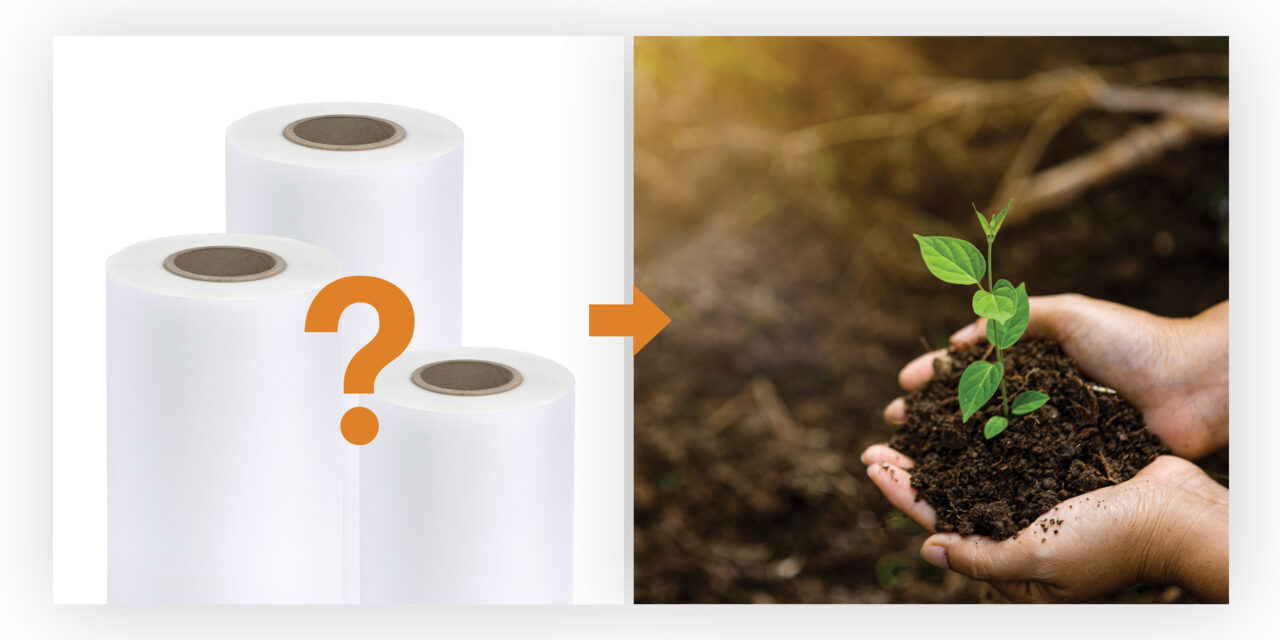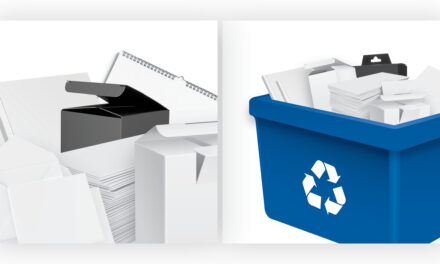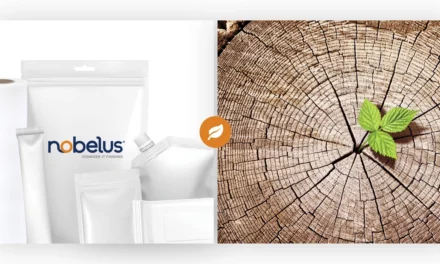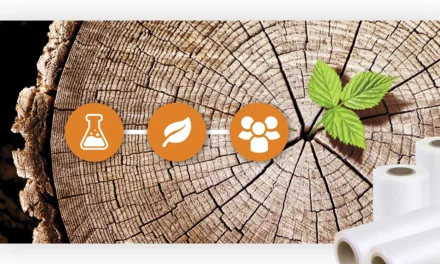THE RISE OF ECO-CONSCIOUS PACKAGING
After decades of proliferous plastic usage, governments and citizens alike across the globe are growing more and more concerned with how modern materials and waste management practices are impacting our ecosystems. According to the United States Environmental Protection Agency (EPA), the plastics most people interact with on a day-to-day basis can take anywhere from decades to centuries to break down, and the majority of recyclable plastics never get repurposed into new materials. This means the amount of plastic that makes its way into landfills, oceans, and even our bodies is continuously growing.
For these and many other reasons, many consumers and brands in the printing and packaging industries are turning away from traditional products and choosing options that reduce or eliminate plastic usage. In the finishing industry, compostable films were introduced as a way to help converters and printers continue producing high-quality products while meeting an ever-increasing demand for more eco-friendly packaging. Let’s take a closer look at what makes a film compostable and how these products can play a crucial role in sustainability initiatives across a wide range of markets.
WHAT DOES ‘COMPOSTABLE’ MEAN?
While the word “compostable” shows up on packaging more frequently now than ever before, its implications may not be immediately obvious to anyone who is new to the sustainability discussion. After all, there are many different ways to integrate sustainable practices into our prints and packaging. Why has “compostable” become a buzz word in recent years? How is “compostable” different than “biodegradable”? How do both terms differ from “recyclable”?
In truth, many products that are marketed as compostable may in fact be only partially compostable, or they may break down only when certain unique criteria are met. Buyers who want to seek out environmentally friendly products should make sure they understand what the labels on a package mean in order to dispose of it in a responsible way. On the other hand, it is the print converter’s duty to validate their claims to avoid greenwashing their products and deceiving consumers. We’ll cover the technical definition of compostable along with a few other terms the average eco-conscious consumer may encounter when selecting which package to purchase.
Compostable
In simple terms, composting is the process of breaking down organic matter into compost so it can be safely returned to the earth or repurposed in a garden to enrich the soil with nutrients. Compostable materials are defined by their ability to decompose naturally at a rate similar to other materials in the compost mixture. These materials decompose due to microorganisms that will continue to feed on them and break them down so long as they have ample water, oxygen, carbon, and nitrogen. While people have been composting food scraps, lawn trimmings, and newspaper for a very long time, it is only in recent years that compostable packaging has been added to the mix.
Still, even compostable films may be incorrectly disposed of depending on whether the film is home compostable or industrial compostable.
Home compostable films will decompose in a standard residential compost environment. Assuming these films are part of a fully home-compostable packaging structure, they can be placed in a backyard bin with adequate amounts of vegetable scraps, dried leaves, coffee grounds, and other organic matter and will ultimately break down completely to become part of the resulting mulch. There are few barriers to home composting apart from time, energy, and proper maintenance. Never place a compostable package into a home compost unless the package is explicitly labeled as home compostable.
Industrial compostable films will not decompose in a residential compost bin (at least, not at the same rate as other components in the compost). Films that are industrial compostable will require more extreme conditions to break down than a home compostable film and therefore must be collected by a composting facility that has the proper equipment, space, and personnel to process the film. While there are several industrial composting methods in use today, not every region or community has access to these facilities. In these instances, the films will go to a landfill just like any other non-compostable material.
Biodegradable
All compostable films are biodegradable, but not all biodegradable films are compostable. Whereas compostable materials will break down at a similar pace to items you would normally find in a compost bin, a biodegradable material is defined simply as a material that will eventually degrade over an indeterminate amount of time in certain conditions. Once the material is broken down, there is no guarantee that it can be repurposed in any way or that it will have no negative effects on the environment.
Recyclable
Recyclable materials make no claims about how quickly they will break down through natural processes. Instead, they are capable of being treated and reprocessed into new materials to be used in the manufacture of other products. Some materials, such as certain types of cardboard, may be both compostable and recyclable. Others, including compostable films, are not suitable for the average recycling bin due to either their composition or limitations recycling facilities face when trying to separate individual film layers. When deciding if a package should go into the recycling bin or the garbage can, always take both the labeling of the package and the instructions on the recycling receptacle into account.
COMPOSTABLE FILM MATERIALS
From the above definitions, it is clear why most consumers prefer compostable packaging. It breaks down through natural processes and leaves behind no toxic residue, which means it can be easily repurposed in a garden for an eco-friendly end-of-life. As consumer demand grows, film manufacturers are investing more time and resources into creating compostable films that can be used on anything from chip bags and granola bar wrappers to on-the-go drink mix packets. In the print and packaging industry, a couple of options tend to rise above the rest when it comes to their feasibility in real-world applications.
Polylactic Acid (PLA) Films
Made from corn, PLA film is well known in the print finishing industry, but it is not used frequently in this space because it runs the risk of softening and deforming at relatively low temperatures, such as inside a car on a hot day. Biaxially oriented polylactic acid (BOPLA) is a mechanically altered version that possesses more durability and higher clarity than standard PLA, but the level of noise the film produces upon being folded or bent makes for a deeply unpleasant customer experience in most flexible packaging applications. (Readers may recall the backlash Frito-Lay faced in the early 2010s with their deafening compostable PLA SunChips® bags.)
However, this does not mean PLA has no use in the packaging industry. It can be used to create bottles, biodegradable medical devices, shrink wrap, and even 3D printing projects. It is not suitable for high-heat applications as high temperatures can make it lose its structure.
Cellulose (CLS) Films
Cellulose is an organic compound that is found in everything from the walls of plant cells to fabrics, paper, and adhesives. Cellulose films are created from regenerated cellulose and generally formed by dissolving the cellulose in a chemical bath to form a solution called viscose, extruding the viscose into a film, and then treating it with several other chemical baths to grant it the properties commonly seen in films.
While cellulose films require significant amounts of energy to produce, the result is a compostable film that boasts resistance to oxygen, liquids, and oils, making it ideal for many types of flexible packaging. Still, it can curl in high-humidity settings unless it receives a protective lacquer layer. Cellulose film can be used to create prime labels, easy tear stick packs, pressure-sensitive tape, and a variety of other items.
SUSTAINABLE NOBELUS FILMS
As a film and laminate supplier for the print and packaging industries, Nobelus understands that we play a crucial role in bringing these more sustainable materials to printers and flexible packaging converters so they can meet growing demand from brands and consumers alike.
To provide our customers with more eco-conscious options, Nobelus has invested significant time and resources into seeking out more sustainable solutions that will supply premium protection to printed images and packaged products. The Nobelus Sustainable Collection is a portfolio of four products that aims to meet the needs of different market segments while still reducing its environmental impact.
A quick disclaimer: Nobelus makes no claims about whether any given packaging structure can be composted. Our suppliers have validated the sustainability claims made concerning the products we sell, and we highly recommend prime label converters, flexible packaging converters, and commercial printers communicate with their own suppliers to ensure the structures and products they create are truly compostable. Combining a compostable film with non-compostable layers will result in an end product that cannot be composted using current methods.
EcoElement™ CLS Films
Completely plastic free and certified home compostable, our EcoElement™ CLS Films are an ideal way to protect printed designs on prime labels and flexible packaging from smudging and scratching. Made from PEFC-certified wood pulp, these cellulose films are produced from renewable resources through a zero-waste manufacturing model and contain 20-25% reprocessed cellulose. This means that any waste that is produced as the film is being extruded and slit is reprocessed to ensure no materials are left unused. Converters can choose between a clear gloss or a subtle matte finish to elevate their printed designs.
EcoElement CLS Film tears very easily, which makes it ideal for easy tear packaging, such as stick packs and sachets, as well as tamper-resistant packaging. However, EcoElement CLS Films are only able to be composted if the rest of the packaging structure is also compostable, so converters should carefully consider what other materials will be used and validate their end-of-life performance before advertising the finished product as compostable.
EcoElement™ CLS Laminates
For the general commercial print industry, Nobelus has EcoElement™ CLS Laminate. While the base film is produced using the same manufacturing process as EcoElement CLS Films, this product is a thermal laminate that has an EVA adhesive backing, which means it can be considered neither plastic free nor compostable under any conditions. However, it does provide printers who need a thermal laminate with a high-quality way to reduce plastic usage in the lamination process. This laminate is also available in both a gloss and matte finish.
WANT TO LEARN MORE ABOUT SUSTAINABILITY IN PRINT FINISHING?
If you want to learn more about sustainable Nobelus products or are interested in learning about how we are investing in research and development to bring more eco-conscious products to market, don’t hesitate to reach out via phone or email. Our product management team and solutions experts are always eager to share their knowledge and discuss which products could work best for your unique operational needs.




